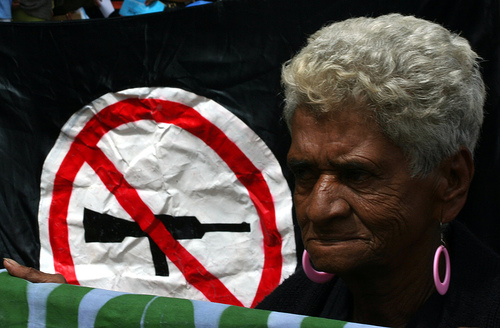The Colombia-Ecuador border is once again a contentious issue. Both countries have a border of 586 km (about 365 miles) and with it a long history of conflict, mutual accusations and reports of armed conflict and displacement. The death of Raúl Reyes, a member of the Colombian rebel group FARC (Revolutionary Armed Forces of Colombia), is perhaps the border’s most well known incident. Reyes died on Ecuadorian territory in March 2008 during a Colombian attack on a FARC base in Angostura, as bc10 [es] recalls. Other serious border issues are insecurity and fear, reports El radar de la frontera [es]. The blog La Historia del Día [es] reports that crimes committed in the area happen in an environment of impunity.
Since Sunday September 19, Twitter users and news channels in both countries have announced, with differing statistics, the number of dead in the latest incident on the border in which FARC members died during an attack by Colombian armed forces, as infobae.com [es] states: “Up to 60 guerillas have died on the border between Ecuador and Colombia.
Reactions from the Ecuadorian side have varied. Twitter users retort the idea that Ecuador would not have supported the Colombian military, as shown in a link posted by Douglas Weber (@HCJBVozAndes)
Ecuador reitera que no se involucra en conflicto colombiano. http://bit.ly/9aPjSg
From Colombia, Hely Rojas (@sysmaya) reports:
Ecuador no reporta novedad en frontera y dice no ayudó Colombia en operativo. http://bit.ly/coQiRY
Luis Alonso Lugo [es] states clearly the position of Ecuador in the words of the Defense Minister for Ecuador, Javier Ponce Cevallos. Cevallos had asked the United States to cooperate further with Colombia to protect the Colombia-Ecuador border. Alonso Lugo says, “Ponce explained that the cooperation of Colombia is essential due to the ‘enormous strain’ it would put on Ecuador to take on the annual cost of 100 million dollars, to keep 10,000 troops, ‘a third of its staff’, on the border area of both countries, where around 140,000 refugees of the Colombian conflict live.”
The invisible border: violence and displacement
The effects of this conflict on the border are numerous, yet the most serious has been the creation of a type of no man’s land. The blog periodismodefrontera [es] (Journalism without borders) reports:
Dentro del análisis de problemas de la frontera norte llevado a cabo a través de las entrevistas y talleres en las tres provincias ecuatorianas de Carchi, Sucumbíos y Esmeraldas, no podemos dejar de remarcar una problemática de elevada importancia y que, en muchas ocasiones, no tiene una gran presencia en los medios de comunicación, pero que repercute en la base del desarrollo social de estas comunidades. Nos estamos refiriendo a la situación en la que se encuentra la infancia en la frontera norte y sobre todo a su vinculación a dos elementos de gravedad: el trabajo infantil y la trata y tráfico de niños y niñas.

"Binational movement of women against war. Colombia-Ecuador border." Image by Flick user padawan used under an Attribution-ShareAlike 2.0 Generic Creative Commons license
Each week 50 Colombian families enter Ecuador either fleeing violence or to protect their children from being taken by armed groups, says Luis Varese, assistant director of the UN office for refugees, Quito, Ecuador [es], who denounced the “silence”:“They recruit boys by force from the age of 12, while girls are seen as “prizes of war” used as a form of currency and for sexual services. Indigenous people, with their knowledge of the jungle, are also valued.”
Ciudadanía Informada [es] reports that children who have a parent from each nationality have no right to citizenship in either country. Natalio Carrasco in the blog Cuaderno de Terreno [es], linked to UNICEF, states that children separated from or not accompanied by their Colombian parents have moved or have sought refuge in Ecuador to avoid being attacked or recruited by gangs. Others have seen members of their family killed.
Es muy probable que las experiencias vividas por estos menores dejen profundas huellas tanto psicológicas como físicas en su desarrollo. En el caso de las niñas, adolescentes y mujeres, aunque los varones no quedan exentos, tienen el peligro de sufrir abusos y de caer en redes explotación sexual comercial y trata de personas.
The organization of indigenous and rural people reports in Voltaire [es]:
Los que en la frontera norte del Ecuador habitamos procedemos de las zonas más empobrecidas del Ecuador y Colombia, llegamos a esa zona luego de grandes esfuerzos, atravesando penurias, buscando días mejores para nosotros y nuestros hijos, algo parecido sucede con los pueblos hermanos de Colombia. Quienes habitamos en la zona de frontera norte de Ecuador y sur de Colombia estamos siendo objeto de atropellos a nuestros derechos humanos y ciudadanos contemplados en la Constitución ecuatoriana vigente y los convenios suscritos por el Ecuador a nivel internacional, solo por el hecho de vivir en la zona fronteriza .
This position is confirmed by Servindi [es] who reports on the death of the Indigenous leader Ramiro Inampues and his wife, María Lina Galíndez who were, “murdered on August 28 in a rural area near the city of Guachucal, close to the border with Ecuador.”
Pio [es] explains the conflict in this area in a forum on the website La Silla Vacía, where users discuss the problems arising from the building of El Corredor Sur [es], a road construction project which aims to connect the two countries which is putting the ethnic population in danger.
Es necesario aclarar que la única etnia en peligro de extinción con este proyecto no son solos los Kofanes, también los Macaguajes (quedan menos de 50), los Sionas, los Coregüajes y en menor medida los Ingas del bajo putumayo. Todos ellos relictos de la cultura Ayahuasquera y su legado espiritual.






